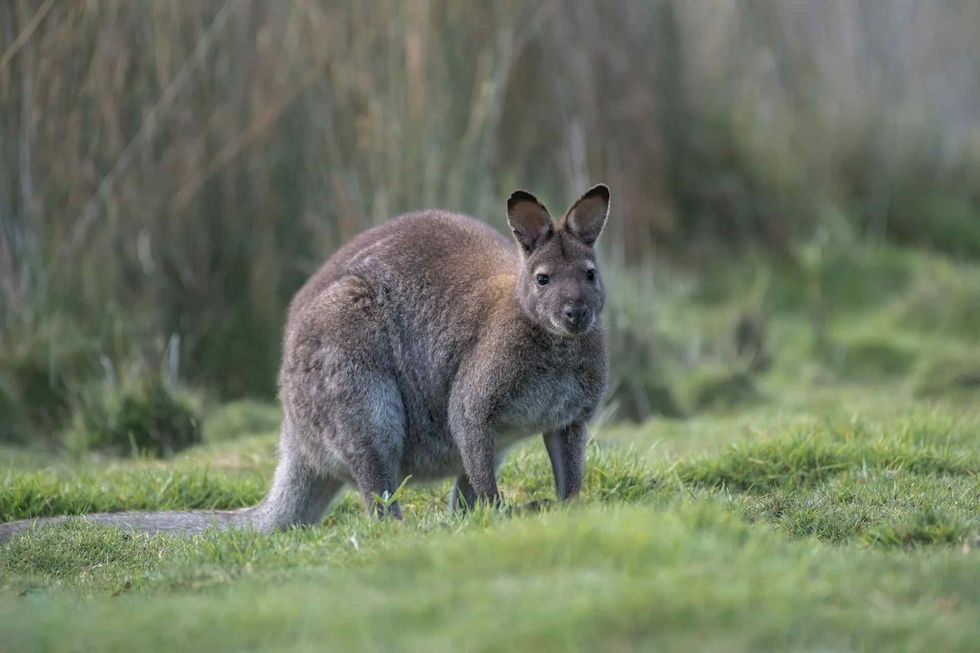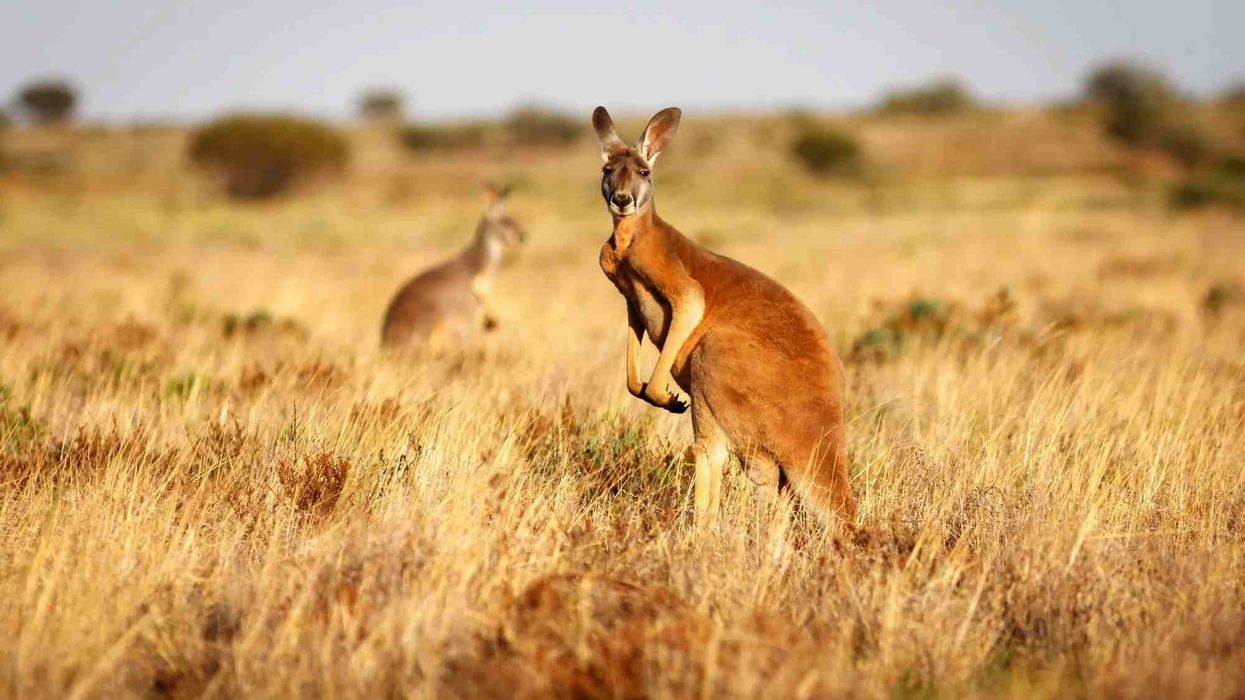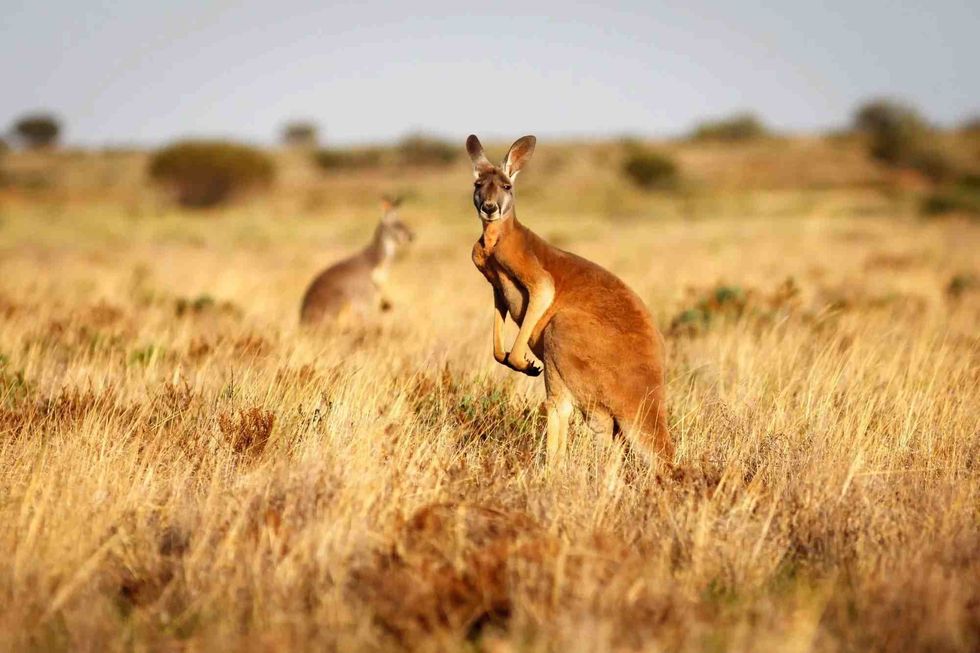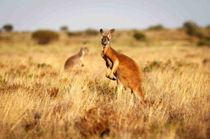Fun Kangaroo And Wallaby Facts For Kids
Content
- What type of animals are kangaroos and wallabies?
- What class of animals do kangaroos and wallabies belong to?
- How many kangaroos and wallabies are there in the world?
- Where do kangaroos and wallabies live?
- What are kangaroos' and wallabies' habitats?
- Who do kangaroos and wallabies live with?
- How long do kangaroos and wallabies live?
- How do they reproduce?
- What is their conservation status?
- What do kangaroos and wallabies look like?
- How cute are they?
- How do they communicate?
- How big are kangaroos and wallabies?
- How fast can kangaroos and wallabies run?
- How much do kangaroos and wallabies weigh?
- What are the male and female names of the species?
- What would you call baby kangaroos and wallabies?
- What do they eat?
- Are they aggressive?
- Would they make good pets?
- Did you know...
- How many species of wallaby are there?
- How are kangaroos good for the environment?
Kangaroos and wallabies are both marsupials with lot a of similarities. Both animals carry their babies (joey) in their pouches. Both the animals are natives of a wide range of Australian forests, plains, and savannahs. Some of the species live in the nearby islands.
The main difference between kangaroo and wallaby is in their size. Kangaroos are bigger and wallabies are considerably smaller. These species belong to the family of macropods. 'Macropod' is a term used for describing the Macropodidae marsupial family.
There is a total of 73 species of macropods including kangaroos, wallabies, wallaroos, pademelons, quokkas (scrub wallaby), tree kangaroos. Kangaroos and wallabies are two species with similar habitats and food habits.
The term ‘kangaroo’ is used for describing the four largest species of these marsupials and wallabies are the smaller macropods. Kangaroos and wallabies both marsupials hop and bounce on their hind legs. The four kangaroos of Australia are the eastern gray kangaroo, the largest red kangaroo, the western gray kangaroo, and the antilopine kangaroo.
Another significant difference between a kangaroo and a wallaby is its fur color. Kangaroos are usually reddish-brown or gray. Wallabies have a glossier coat that can be shades of brown, red, fawn, gray, black, or white.
You may also check out the fact files on sloth bear and Asiatic black bear from Kidadl.
Kangaroo And Wallaby Interesting Facts
What type of animals are kangaroos and wallabies?
Kangaroos and wallabies are marsupials native to Australia, Tasmania, New Guinea, and other islands around the island continent. They belong to the Macropus genus, with a group of animals living in similar habitats.
Most of the members of the Macropus species have larger hind legs compared to their forelimbs. The bigger hind feet and their long, strong, muscular tail help them to maintain balance as they hop on their feet.
What class of animals do kangaroos and wallabies belong to?
Kangaroos and wallabies are mammals. These Macropus species are mostly found in eastern Australia. The Australian capital of Canberra has the maximum concentration of kangaroos.
How many kangaroos and wallabies are there in the world?
It is difficult to give the exact number of kangaroos and wallabies in the world. There are several Macropus species spread in and around Australia and New Guinea.
Where do kangaroos and wallabies live?
The red kangaroos prefer arid regions of Australia and flat open plains. The eastern gray kangaroos live in the un-spoilt wilderness of Cape York to the island state of Tasmania.
The western gray kangaroos have a wide range starting from Western Australia till south-eastern Australia’s Victoria state. Both the eastern gray kangaroos and the western gray kangaroos like to live in dense vegetation.
Different species of kangaroos and wallabies have individual preferred habitats but mostly live in forested lands of Australia, Tasmania, Papua, and New Guinea. Kangaroos are common animals in zoos in most countries.
What are kangaroos' and wallabies' habitats?
Kangaroos live in forests, woodlands, plains, and savannas in Australia, Tasmania, and the nearby islands. What kind of ecosystem a kangaroo or a wallaby species occupies depends on their species.
Different Macropus marsupials have their specific ranges like the eastern gray kangaroo or the Macropus giganteus inhabits then Eastern Australian and Tasmanian open forests. The western gray kangaroos or the M. fuliginosus are found in areas of southern and western Australia.
Similarly, different wallaby species can be found in diverse habitats. The rock wallaby prefers rugged terrains, rocky and hilly areas, and stays among boulders, and in caves. Some other wallaby species favor dens in arid and grassy areas.
The yellow-footed rock wallaby has the brightest, and the most colorful fur among the kangaroos and the wallabies. The brown, yellow, gray, and white fur is a camouflage adaptation feature that helps these animals to hide among the surrounding rocks. Red-necked wallaby is commonly found in the fertile and temperate areas of eastern Australia.
Who do kangaroos and wallabies live with?
Both kangaroos and wallabies species are social animals and show similar social behavior. Both macropods live in groups called mobs lead by dominant males. Each kangaroo mob may consist of few dozens to more than a hundred kangaroos.
The larger and the smaller wallaby species show different traits. The larger animals stay in big mobs of about 50 wallabies. Some of the smaller species of these animals prefer to live solitary lives.
How long do kangaroos and wallabies live?
Different species of kangaroos and wallabies have different lifespans. A western gray kangaroo can live for 20 years or more in captivity or zoos.
However, in the wild, these animals native to Australia can live for about 10 years. Most kangaroos in the wild don’t even survive till they reach their adult stage. Swamp wallabies have a life expectancy of 15 years in the wild.
How do they reproduce?
Kangaroos and wallabies get pregnant in the same way as all mammals - sexually. But certain fascinating features are different about macropod reproduction.
Once the mother kangaroo has given birth to a joey or a baby kangaroo, it’s time to mate again. However, the second baby is only a bundle of about 100 cells and stops growing, waiting for the previous joey to vacate the pouch.
Kangaroo mothers usually have babies after every nine months to one year. This unique ability to suspend a pregnancy is not common in mammals.
It is called embryonic diapause and the Macropus group of species like kangaroos and wallabies is gifted with it. The embryonic diapause gives the mother kangaroo an advantage of replacing a baby in case a young one does not survive.
Like all kangaroos, the red kangaroo reproduces sexually. The process begins as soon as the male courts the female kangaroo.
This species has the simplest courtship activities compared to all the kangaroo species. Courtship rituals include the male kangaroo flexing its muscles to attract a female. There can be mating rivalry fights too among two males.
Females usually have one joey at a time. When joeys are born they immediately crawl into the mother's pouch. The baby kangaroo steps out of the pouch as an independent animal only after about six months.
Different kangaroo species have varied breeding seasons. Reproduction happens all through the year but the summer months of December to February in the Southern Hemisphere are most common.
The gestation period lasts for around 36 days. A newborn joey is a size of a grape.
It weighs about .01 lb (45.3 g) and is smaller than 1 in (2.5 cm) in length. Right after it is born, the joey uses its forelimbs and its mother’s fur to travel to the pouch.
When the joey is about nine months old, it starts leaving the mother’s pouch for small intervals in the beginning until it is ready to live independently. Similar to kangaroo babies, wallaby babies are born helpless and tiny. They follow a similar process of growth as the kangaroos.
Young wallabies are also called joeys. The funny part is that, even after leaving the pouch, a young joey at the hint of any danger often jumps inside the mother’s pouch.
What is their conservation status?
The conservation status of varied kangaroo and wallaby species is different. According to the IUCN Red List 2014, the Matschie's tree kangaroos are Endangered.
The estimated population of these wild animals was only two thousand and 25 or less. A major threat to kangaroos and wallabies is habitat destruction caused by human activities like logging and mining. In New South Wales, the kangaroos, and the smaller wallaroos and wallabies are protected by the Biodiversity Conservation Act 2016 (BC Act).
The conservation status of the most common larger kangaroos is considered to be of Least Concern, while for wallabies the IUCN Red List status is Near Threatened. Studies show the population of kangaroos is around 40-50 million, which surpasses the number of people living in Australia.
Although kangaroos do not have too many predators in the wild, humans are their main threats. Hunting kangaroos for flesh and skin has been a centuries-old practice in Australia.
Additionally, land clearing for urbanization also leads to loss of habitat. When predators like foxes and wild dogs called dingoes threaten a kangaroo, the animal uses its flat teeth, claws, feet, and powerfully built hind legs to defend itself.
Kangaroo And Wallaby Fun Facts
What do kangaroos and wallabies look like?
Barring tree kangaroos, all kangaroo and wallaby Macropodidae family members depend on their long, strong hind legs, and feet for leaping and hopping movements. The long tail helps in balancing the body. It is thickened at the base and narrows towards the end.
The large kangaroos use the tail as a third limb. This is well evident in the large kangaroos. They use the tail as a third leg while standing.
The hind feet have four toes. The fourth toe is the largest and bears the maximum weight of the animal. The second and the third toe are almost connected.
The forelimbs are short and have five unequal digits. These limbs are used like human hands. All the digits have sharp claws.
A kangaroo's head is comparatively smaller than its body. They have large, rounded ears, a small mouth, and prominent lips. Their teeth have complex high-crowned settings. The kangaroo fur is short, soft, and woolly.
Some species have grizzled or striped fur on the upper limbs or back of the head and back. Coat colors vary, depending on the kangaroo and wallaby species. The fur color can be shades of red, orange, gray, or and brown.

How cute are they?
Kangaroos are one-of-a-kind animals inhabiting Australia. They are strong, big, wild animals that are not cuddly as dogs and cats but they are cute in their sweet ways. Wallabies are smaller and are very sweet.
How do they communicate?
Kangaroos are generally docile if not provoked, or threatened. They are vocal animals and communicate by growling, coughing, and making loud barking sounds. Another way of communication is through stomping. A mother kangaroos communicate with the joey with soft, clucking, and clicking sounds.
Male kangaroos frighten and challenge their opponents with grumbling sounds. They growl when threatened. Some males of the eastern gray kangaroo species have been seen to converse with female kangaroos with soft clucking sounds.
How big are kangaroos and wallabies?
Kangaroos and wallabies are of different sizes. The largest kangaroo, the red kangaroo can weigh around 200 lb (90.7 kg). Compared to that, a koala another marsupial native to Australia weighs only 9-33 lb (4-15 kg). A kangaroo is about 22 times heavier than a koala.
How fast can kangaroos and wallabies run?
Kangaroos can’t run. Their means of locomotion is through hopping. A red kangaroo moves at a speed of 37 mph (60 kph). With every hopping movement, they can clear about 314 in (797.5 cm).
Kangaroos are also great swimmers. The tail is used while these animals swim. Kangaroos swim to avoid predators on land. These strong animals can even use their forepaws to push and drown their pursuers.
How much do kangaroos and wallabies weigh?
Kangaroos are the largest marsupials. A red kangaroo is the largest of the species can weigh up to 200 lb (90.7 kg). They grow up to almost 79 in (200.6 cm) tall. The smallest is the black wallaroo, weighing around 44lb (20 kg).
What are the male and female names of the species?
Adult male kangaroos and wallabies are called bucks, boomers, or jacks. The adult female kangaroos and wallabies are called do, jills, or flyers. When they are in a group, wallabies are collectively called a mob, court, or troupe.
What would you call baby kangaroos and wallabies?
Young kangaroos and wallabies are called joeys.
What do they eat?
Kangaroos and wallabies are herbivores. The main part of their diet includes grasses, leaves, shrubs, ferns, fruits, and flowers. Some of the Macropus species also eat selected fungi and moss.
Kangaroos may regurgitate or chew the cud before finally swallowing their food. Kangaroos have a different kind of stomach than cows or other ruminant animals. Although, like cows, kangaroos have a chambered stomach, they do not produce too much methane like cows.
Kangaroos are most active early in the morning or at night. This behavior may differ according to different marsupial species of their kinds. Daytime is their resting period, especially in hot weather. These animals can go without water for long periods. Some amount of water from their diet of leaves and plants also satisfies their requirement for water.
Besides leaves and fruits, they also feed on bark, seeds, and plant sap. Their preferred choices are bamboo shoots, maple branches, and willow. Some omnivorous tree-kangaroo species eat eggs from bird nests.
The yellow-footed rock-wallaby mostly eats grasses. In the dry season also feed on fallen leaves on the ground as food becomes scarce in its rocky habitat. These animals can drink water that’s more than 10% of their body weight at one go. They just require a few minutes to do it.
Are they aggressive?
Kangaroos are usually gentle animals. However, if they feel threatened they may show aggressive behavior towards humans and other animals. In wild and captivity, kangaroos and wallabies that are used to interacting with humans may approach people for food, and not getting it may anger them. Wallabies are not dangerous but can kick and scratch if they feel threatened.
Would they make good pets?
Kangaroos are wild pets that cannot be confined inside a house. They need huge open space to graze and hop around. Some species of kangaroos and wallabies are considered pests in agricultural development.
Did you know...
Kangaroo mobs, or groups known as troops or herds, are headed by a dominant male.
The kangaroo is an important animal of Australia. It appears as a symbol on the Australian coat of arms, on the country’s currency, on the logo of Qantas Airlines and other Australian organizations. These marsupials are a tourist attraction. These animals are also culturally important in Australia.
The musky rat-kangaroo is the smallest kangaroo of the lot. Its height is only 6-8 in (15.2-20.3 cm).
Kangaroos lick their arms to keep their skin moist and body cool.
In the wild, kangaroos and wallabies do not mate, but hybrids have been created in captivity through forced mating, to create wallaroos, with genetic makeup closer to wallabies.
How many species of wallaby are there?
There are about 30 wallaby species that are named according to their size and habitat. Some wallabies are the tammar wallaby, red-necked wallaby, rock wallaby, hare wallaby, brush wallaby, shrub wallaby. The red-necked wallaby is called so because of its fur color.
How are kangaroos good for the environment?
Kangaroos are herbivores and ruminant animals like cows. However, they do not release methane like most cattle. Methane is a major greenhouse gas that adds to global warming.
Here at Kidadl, we have carefully created lots of interesting family-friendly animal facts for everyone to discover! For more relatable content, check out these red kangaroo facts and white rhinoceros facts for kids.
You can even occupy yourself at home by coloring in one of our free printable funny kangaroo coloring pages.
We Want Your Photos!
More for You
See All
Bachelors in Business Administration

Aashita DhingraBachelors in Business Administration
Based in Lucknow, India, Aashita is a skilled content creator with experience crafting study guides for high school-aged kids. Her education includes a degree in Business Administration from St. Mary's Convent Inter College, which she leverages to bring a unique perspective to her work. Aashita's passion for writing and education is evident in her ability to craft engaging content.
Disclaimer
1) Kidadl is independent and to make our service free to you the reader we are supported by advertising. We hope you love our recommendations for products and services! What we suggest is selected independently by the Kidadl team. If you purchase using the Buy Now button we may earn a small commission. This does not influence our choices. Prices are correct and items are available at the time the article was published but we cannot guarantee that on the time of reading. Please note that Kidadl is a participant in the Amazon Services LLC Associates Program, an affiliate advertising program designed to provide a means for sites to earn advertising fees by advertising and linking to Amazon. We also link to other websites, but are not responsible for their content.
2) At Kidadl, we strive to recommend the very best activities and events. We will always aim to give you accurate information at the date of publication - however, information does change, so it’s important you do your own research, double-check and make the decision that is right for your family. We recognise that not all activities and ideas are appropriate for all children and families or in all circumstances. Our recommended activities are based on age but these are a guide. We recommend that these ideas are used as inspiration, that ideas are undertaken with appropriate adult supervision, and that each adult uses their own discretion and knowledge of their children to consider the safety and suitability. Kidadl cannot accept liability for the execution of these ideas, and parental supervision is advised at all times, as safety is paramount. Anyone using the information provided by Kidadl does so at their own risk and we can not accept liability if things go wrong.
3) Because we are an educational resource, we have quotes and facts about a range of historical and modern figures. We do not endorse the actions of or rhetoric of all the people included in these collections, but we think they are important for growing minds to learn about under the guidance of parents or guardians.







